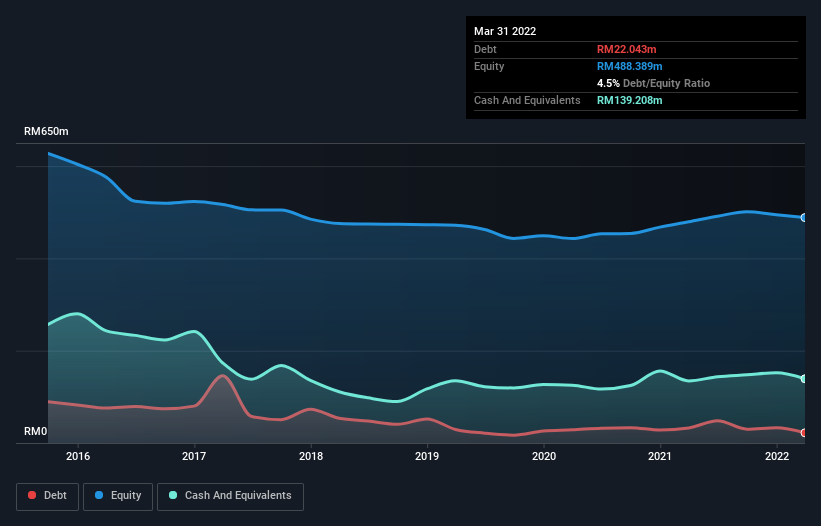- Malaysia
- /
- Water Utilities
- /
- KLSE:SALCON
We Think Salcon Berhad (KLSE:SALCON) Can Manage Its Debt With Ease
Legendary fund manager Li Lu (who Charlie Munger backed) once said, 'The biggest investment risk is not the volatility of prices, but whether you will suffer a permanent loss of capital.' So it seems the smart money knows that debt - which is usually involved in bankruptcies - is a very important factor, when you assess how risky a company is. We can see that Salcon Berhad (KLSE:SALCON) does use debt in its business. But is this debt a concern to shareholders?
Why Does Debt Bring Risk?
Debt assists a business until the business has trouble paying it off, either with new capital or with free cash flow. In the worst case scenario, a company can go bankrupt if it cannot pay its creditors. However, a more usual (but still expensive) situation is where a company must dilute shareholders at a cheap share price simply to get debt under control. Of course, debt can be an important tool in businesses, particularly capital heavy businesses. The first step when considering a company's debt levels is to consider its cash and debt together.
Check out our latest analysis for Salcon Berhad
What Is Salcon Berhad's Net Debt?
As you can see below, Salcon Berhad had RM22.0m of debt at March 2022, down from RM32.5m a year prior. However, it does have RM139.2m in cash offsetting this, leading to net cash of RM117.2m.

How Strong Is Salcon Berhad's Balance Sheet?
Zooming in on the latest balance sheet data, we can see that Salcon Berhad had liabilities of RM129.2m due within 12 months and liabilities of RM21.2m due beyond that. Offsetting this, it had RM139.2m in cash and RM167.0m in receivables that were due within 12 months. So it actually has RM155.8m more liquid assets than total liabilities.
This surplus liquidity suggests that Salcon Berhad's balance sheet could take a hit just as well as Homer Simpson's head can take a punch. With this in mind one could posit that its balance sheet means the company is able to handle some adversity. Simply put, the fact that Salcon Berhad has more cash than debt is arguably a good indication that it can manage its debt safely.
Notably, Salcon Berhad's EBIT launched higher than Elon Musk, gaining a whopping 1,108% on last year. There's no doubt that we learn most about debt from the balance sheet. But you can't view debt in total isolation; since Salcon Berhad will need earnings to service that debt. So when considering debt, it's definitely worth looking at the earnings trend. Click here for an interactive snapshot.
Finally, a company can only pay off debt with cold hard cash, not accounting profits. Salcon Berhad may have net cash on the balance sheet, but it is still interesting to look at how well the business converts its earnings before interest and tax (EBIT) to free cash flow, because that will influence both its need for, and its capacity to manage debt. Over the last two years, Salcon Berhad actually produced more free cash flow than EBIT. That sort of strong cash generation warms our hearts like a puppy in a bumblebee suit.
Summing Up
While it is always sensible to investigate a company's debt, in this case Salcon Berhad has RM117.2m in net cash and a decent-looking balance sheet. The cherry on top was that in converted 264% of that EBIT to free cash flow, bringing in RM30m. The bottom line is that Salcon Berhad's use of debt is absolutely fine. There's no doubt that we learn most about debt from the balance sheet. But ultimately, every company can contain risks that exist outside of the balance sheet. For instance, we've identified 1 warning sign for Salcon Berhad that you should be aware of.
Of course, if you're the type of investor who prefers buying stocks without the burden of debt, then don't hesitate to discover our exclusive list of net cash growth stocks, today.
New: Manage All Your Stock Portfolios in One Place
We've created the ultimate portfolio companion for stock investors, and it's free.
• Connect an unlimited number of Portfolios and see your total in one currency
• Be alerted to new Warning Signs or Risks via email or mobile
• Track the Fair Value of your stocks
Have feedback on this article? Concerned about the content? Get in touch with us directly. Alternatively, email editorial-team (at) simplywallst.com.
This article by Simply Wall St is general in nature. We provide commentary based on historical data and analyst forecasts only using an unbiased methodology and our articles are not intended to be financial advice. It does not constitute a recommendation to buy or sell any stock, and does not take account of your objectives, or your financial situation. We aim to bring you long-term focused analysis driven by fundamental data. Note that our analysis may not factor in the latest price-sensitive company announcements or qualitative material. Simply Wall St has no position in any stocks mentioned.
About KLSE:SALCON
Salcon Berhad
Operates as water and wastewater engineering company in Malaysia, the United States, India, the United Kingdom, and internationally.
Flawless balance sheet and fair value.
Market Insights
Community Narratives



